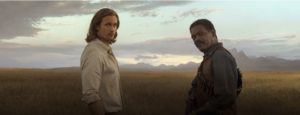
Alexander Skarsgard and Samuel L. Jackson in ‘The Legend of Tarzan’/Image © Warner Bros.
By Valerie Kalfrin
Signature Reads, June 29, 2016
“The Legend of Tarzan” swings into theaters on July 1, reintroducing a century-old character and cultural icon who embodies the lure of the wild. A son of British aristocrats who is orphaned and raised by apes, Tarzan has appeared onscreen in some form – movie, TV show, or video game – more than 100 times, usually shirtless and moving across the jungle via vines. Author Edgar Rice Burroughs created Tarzan in 1912 as a noble hero with a love of the natural world, intelligent and well-spoken in spite of his feral upbringing thanks to his human parents’ library.
“I do not understand exactly what you mean by fear,” Tarzan says in the novel Tarzan of the Apes. “Like lions, fear is a different thing in different men, but to me the only pleasure in the hunt is the knowledge that the hunted thing has power to harm me as much as I have to harm him.”
Hollywood often cast athletes instead of actors as Tarzan, making him a primitive character who spoke in broken English, but his adventures still stemmed from clashes between civilized society and his so-called untamed state. This latest endeavor, starring Alexander Skarsgård (“True Blood”), places Tarzan in trousers instead of a loincloth and upends the typical onscreen framework. Here, Tarzan has left the jungle to live in England, where he’s embraced his heritage as John Clayton III, Lord Greystoke. He returns to the Congo to serve as a trade emissary, landing him and his beloved wife, Jane (Margot Robbie of “The Wolf of Wall Street”), in danger, then reconnects with his primal side.
“
Written by Adam Cozad (“Jack Ryan: Shadow Recruit”) and Craig Brewer (“Hustle and Flow,” “Footloose”), the film costars Samuel L. Jackson, Christoph Waltz, and Djimon Hounsou. The African jungle also is a vivid character, said director David Yates (“Harry Potter and the Deathly Hallows” Parts 1 and 2), who was as enthralled with the setting as Burroughs’s readers decades earlier.
“A lot of movies, you have to go to the far reaches of the galaxy to find extraordinary beauty and amazing things,” Yates said, but “they’re right here on the planet. They exist just a few thousand miles away.”
Whether campy or serious, Tarzan has undeniable staying power. Here’s a look at some of his jungle journeys over the years.
“Tarzan of the Apes” (1918)
This silent film is the character’s onscreen debut and fittingly follows the origin story Burroughs established. Elmo Lincoln, who also appeared in “The Romance of Tarzan” (1918) and “The Adventures of Tarzan” (1921), played the lead, although another actor, Stellan Windrow, was cast first and appears uncredited in footage of Tarzan swinging from the trees. Windrow quit the film to enlist in World War I. Louisiana stood in for the African jungle, with locals playing extras as well as some of the apes.
“Tarzan and His Mate” (1934)
Olympic swimmer Johnny Weissmuller played Tarzan for a dozen films, from 1932’s “Tarzan the Ape Man” through 1948’s “Tarzan and the Mermaids.” Maureen O’Sullivan (“Hannah and Her Sisters”) frequently appeared as his sweetheart, Jane, living in a quaint treehouse, searching for secret treasure, and even visiting New York City (!) with him. Of all their pairings, film buffs tend to like this one best. Co-written by James Kevin McGuinness (“Rio Grande”), the film finds the couple’s life interrupted by huntsmen searching for an elephant burial ground and includes Jane skinny-dipping, showing the former society gal demonstrably free of society’s constraints. Olympic swimmer Josephine McKim actually performed in the scene, which was restored to the film in the late 1990s after being discovered in the vaults of Turner Entertainment.
“Tarzan’s Greatest Adventure” (1959)
Former infantry drill instructor Gordon Scott played Tarzan for six films, including a TV movie, in the mid-1950s until 1960 – and returned him to speaking full sentences along the way. His portrayal showed Tarzan as a loner, save for his chimpanzee sidekick Cheetah, and a roving hero who protected settlements and lost airline passengers. This penultimate film for Scott costars Sean Connery in a supporting role. Connery had been asked to play Tarzan afterward but at the time, he had already been cast in what he called “some spy picture”: 1962’s James Bond film “Dr. No.”
“Tarzan and the Valley of Gold” (1966)
Tarzan became “a globetrotting troubleshooter of super-villains” who could communicate with animals and wield high-powered weapons for a few films in the 1960s starring Mike Henry, a former football player for the Pittsburgh Steelers and Los Angeles Rams. Henry endured delirium after a chimp bite on the chin during his next outing, “Tarzan and the Great River” (1967) and would go on to appear in “Rio Lobo,” “Soylent Green,” and “M*A*S*H*”.
“Greystoke: The Legend of Tarzan, Lord of the Apes” (1984)
Directed by Hugh Hudson (“Chariots of Fire”) and co-written by Robert Towne (“Chinatown”), this serious-minded take on the Tarzan story restored some glory to the character after 1981’s “Tarzan the Ape Man,” co-starring Bo Derek as Jane, veered into softcore territory. Christopher Lambert played Tarzan, and Ralph Richardson earned an Oscar for Best Supporting Actor as the Sixth Earl of Greystoke. Andie MacDowell makes her film debut as Jane, with Glenn Close dubbing her voice because of MacDowell’s Southern accent.
“Tarzan” (1999)
Other than “Greystoke,” this Disney animated film is the Tarzan story that modern audiences likely remember best. Yet another take on Tarzan’s origin, albeit with talking apes, this film features Tony Goldwyn (TV’s “Scandal”) as the voice of Tarzan, Minnie Driver (“Good Will Hunting”) as Jane, and an Oscar-winning song by Phil Collins (“You’ll Be in My Heart”). It also showcased Tarzan surfing on tree branches instead of always getting into the swing of things.
From http://www.signature-reads.com/2016/06/a-world-of-tarzan-6-greatest-greystroke-adventures/
